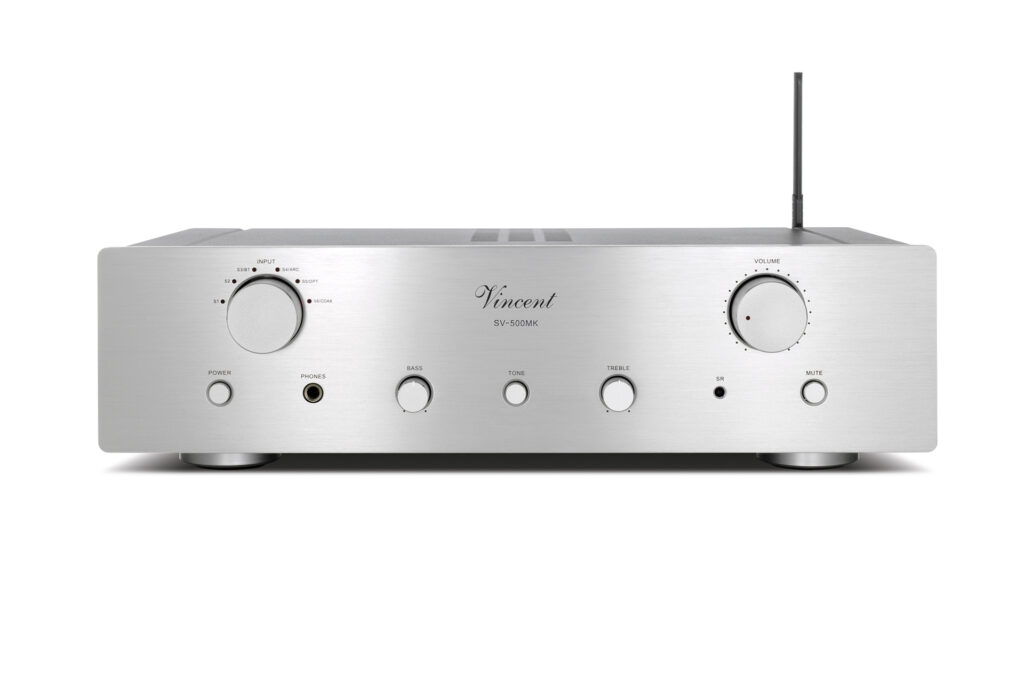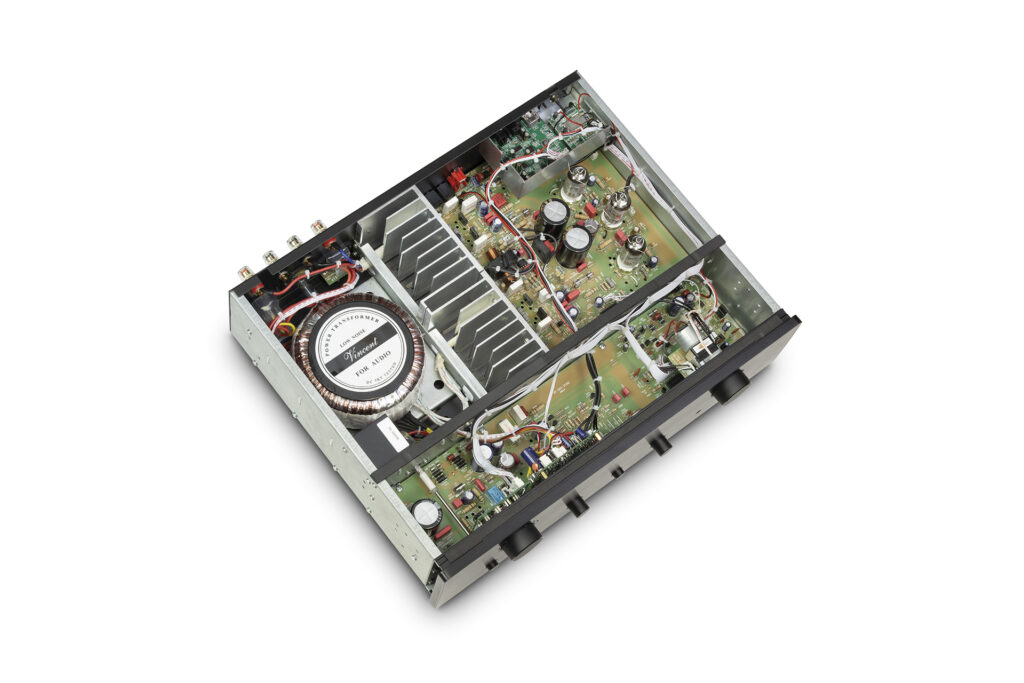Vincent Audio is now shipping a new, updated edition of one of its most popular hybrid integrated amplifiers to date.
Shipping this month, SV-500 MK (SRP: $1,499.95 USD) builds on the foundation of its predecessor, SV-500, with the addition of HDMI and Bluetooth to its extensive list of top-shelf components, including a 32-bit 384 kHz-capable DAC and an industry-leading hybrid vacuum tube and solid-state design.
“From the time of its introduction, the Vincent Audio SV-500 was and continues to be praised by dealers and consumers alike,” said Steve Niemi, Director of Global Sales, Pangea Audio Distributing, LLC. “It’s continually cited as one of the best examples of hybrid designs in the sub-$2,000 price range.

“As much as the technology and sonics continue to lead the category, Vincent Audio saw there was room for an upgrade by way of expanding compatibility with an exponentially wider array of sources, which led Vincent Audio to the addition of HDMI and Bluetooth connectivity.”
Vincent Audio’s SV-500 MK integrated amplifier features six inputs — two analog and four digital – including Bluetooth 5.0 and HDMI with ARC (Audio Return Channel).
At the heart of the SV-500 MK is a Vincent Audio-exclusive circuit that features three user-replaceable vacuum tubes: (2) 6N1 and (1) 12AX7. The tubes are biased for longer life, conservatively estimated to be 10 years.
In addition to making analog sources sound their best, the SV-500 MK is up-to-date with a DAC that handles the latest high-resolution streaming formats, including WAV, FLAC, AIFF, APE, and more. A robust power supply maintains a current flow that is clean and free of noise.
Adds Mr. Niemi: “As one of our most popular hybrid integrated amplifiers to date, the SV-500 set a high bar in sonic output and usability that stands out from competitors in its price class. The new SV-500 MK builds on the latter, while maintaining the integrity of the former.”
For further information about the Vincent Audio SV-500 MK click here.

Vincent Audio SV-500 MK Features and Specifications
• Hybrid vacuum tube and solid-state design
• New HDMI and Bluetooth inputs
• Digital inputs decodes 16-bit, 24-bit and 32-bit audio files up to 384 kHz
• Front panel headphone jack
• Inputs: 2 x Stereo RCA, 1 x Optical, 1 x Coax, 1 x HDMI, 1 x Bluetooth 5.0
• Outputs: 1 x Stereo Rec Out, 1 x Stereo Pre Out, 2 x 3.5mm Jack (Power control), 1 x pair of speaker connectors
• Tubes: 1 x 12AX7, 2 x 6N1
• Wireless remote
• Color: Black or silver
—
Specifications
• Frequency response: 20Hz – 20kHz (+/- 0.5dB)
• Output power 8 Ohm: 2 x 50 Watts RMS
• Output power 4 Ohm: 2 x 80 Watt RMS
• Input sensitivity: 420mV
• THD: < 0.1% (1kHz, 1W)
• Signal to noise range: >90dB
• Input impedance: 47 kOhm
• Dimensions: 17″ wide x 4.6″ high x 14.7″ deep
• Weight: 22 lbs.
The History of Vincent Audio
Vincent Audio is one of those audiophile brands that has quietly earned respect over the years by focusing on fundamentals: solid engineering, hybrid designs, no-nonsense build quality, and competitive pricing. Based in Germany, with manufacturing rooted in Asia, Vincent has carved out a space in the mid-tier and high-value segment of the hi-fi market—particularly appealing to listeners who want the sonic benefits of tubes without fully diving into vintage or boutique gear.
The company was founded in the mid-1990s as part of Sintron Vertriebs GmbH, a German audio distributor and parent company for several hi-fi brands. Vincent emerged at a time when the high-end audio world was increasingly split between digital-first designs and the beginnings of the home theater boom. Amid this shift, Vincent stuck to its lane: two-channel gear, built around the idea that musicality, warmth, and realism mattered just as much—if not more—than raw technical specs.
Vincent’s early reputation was built on its hybrid amplification designs, which combined vacuum tube preamp stages with solid-state output stages. This “best of both worlds” approach aimed to deliver the rich, full-bodied midrange of tube gear with the power, control, and reliability of solid-state amplification. Models like the SV-236 and SV-226 were among the early integrated amps that put Vincent on the map. They offered clear tube influence in voicing—smooth top end, open midrange—but without the wooliness or sluggishness that can come from all-tube circuits in affordable price points.
From there, Vincent expanded its lineup to include separates, including dedicated preamps, power amps, DACs, and phono stages. The brand also maintained a consistent industrial design aesthetic—chunky aluminum faceplates, symmetrical layouts, large volume knobs, and LED-lit tube windows. The gear feels substantial without drifting into overbuilt territory. Vincent doesn’t try to dazzle you with luxury finishes or unnecessary complication. The focus remains on performance per dollar, especially for listeners building systems in the $1,000–$5,000 range.
The company also gained a following with its Power Line and Tube Line series, which helped clarify product categories. The Tube Line models leaned into the hybrid concept, with tubes in the input stage and solid-state for the heavy lifting. These designs have proven popular among vinyl listeners, headphone users, and two-channel fans looking to add some musical color to their systems without sacrificing drive or control.
Vincent’s DACs and CD players also found an audience, particularly among those looking for a traditional source that pairs visually and sonically with the amplifiers. Models like the CD-S7 DAC and CD-S1.1 showed that the company could handle digital-to-analog conversion with the same attention to balance and tonal richness found in their analog gear.
A key factor in Vincent’s ongoing appeal is that it hasn’t tried to chase every trend. You won’t find Bluetooth receivers, touchscreen interfaces, or wireless streaming modules baked into their amps. The brand has remained firmly grounded in physical media and line-level sources, appealing to users who prioritize sound quality and stability over constant feature updates. This consistency has helped them develop a loyal customer base, especially among listeners who started with Vincent and then upgraded within the line over time.
While Vincent is often associated with value-based performance, the brand has not hesitated to move upmarket when it made sense. Products like the SV-700 integrated amp and SP-332 power amplifier demonstrated Vincent’s ability to compete with more expensive high-end gear, offering improved circuit designs, higher-quality parts, and more refined finishes while staying below the price points of more boutique manufacturers.
Another part of Vincent’s success lies in its global distribution strategy. Though headquartered in Germany, the gear is assembled and manufactured in Asia, which allows the brand to keep prices in check while still maintaining German engineering oversight. Vincent’s equipment is imported to North America through companies like Audio Advisor, and it’s common to see their amps recommended as high-value alternatives to more expensive tube or solid-state competitors from Europe, the U.S., or Japan.
Vincent also appeals to a demographic that values tactile engagement with gear. There’s something reassuring about powering on a Vincent amp, watching the tubes glow through the window, and turning that big volume knob. It’s an experience—a reminder that hi-fi can still feel mechanical and physical in a way that digital-first products often don’t.



